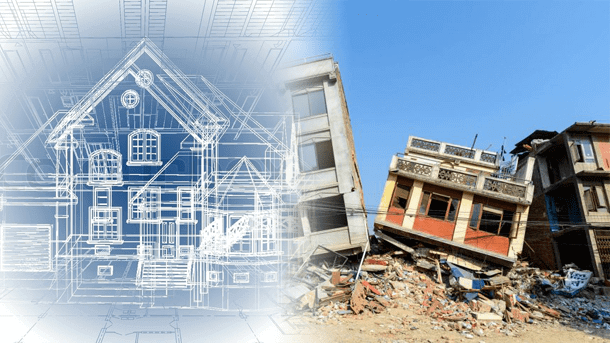Architects perpetually wish to make building designs that are functional and aesthetic. But the choice of structure and shapes has a huge impact on the overall building performance when there are strong tremors. How do architectural features exactly affect buildings during earthquakes?

Building size
In buildings that stand tall, and have big height-to-base size ratio, there is big horizontal floor movement when the earth shakes. For buildings that are long but short-statured, there are numerous damaging impacts during earthquakes. In warehouse-like buildings, the walls and columns may crumble under excessive horizontal seismic forces.
Horizontal building layout
Buildings with a basic geometrical plan usually stand well during severe earthquakes. Those with +, H, V and U shapes and with re-entrant corners suffer severe damages. Those with an L-shaped plan may be divided into 2 rectangular shapes with the help of an isolated joint in the middle. Such architectural features twist when the earth shakes.
Vertical building layout
Hotels and similar buildings having vertical setbacks jump abruptly at the discontinuity level under the forces of earthquake. Those with lesser number of walls or columns in a specific storey tend to collapse or suffer damages in that same storey. During the devastating earthquake of 2001 in Bhuj, Gujarat, lots of buildings having an open ground storey designed for parking vehicles got damaged severely or collapsed entirely.
Proximity
Once two buildings happen to be adjacent to each other, they can hit one another when the earth shakes very strongly. The collision may be a bigger issue when the buildings are taller in stature. When the height of buildings does not correspond, the roof of smaller buildings can hit the column of bigger buildings at a mid-level height. It can be extremely dangerous.
Building Codes and Designs
It is a given that architects will go on making buildings that appear interesting instead of boring and run-of-the-mill. But the earthquake-safety, cost and other factors should not be compromised for aesthetics. Architects should avoid features that have a negative impact on building’s response to earthquakes. Even in those cases where such features cannot be avoided, it is important to minimize them. When buildings have irregular features, many more engineering efforts are needed to improve the structural design. The buildings might still not be as good as those with basic architectural features. It is important to take proper decisions at the stage of planning on the configuration of buildings.
To know more information, visit https://toptechtmt.com/







